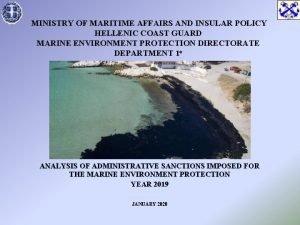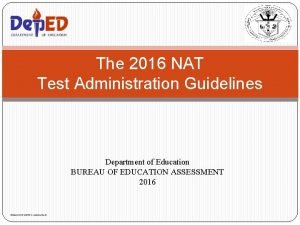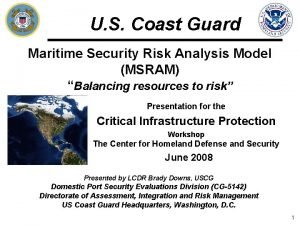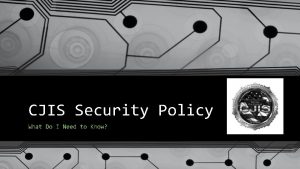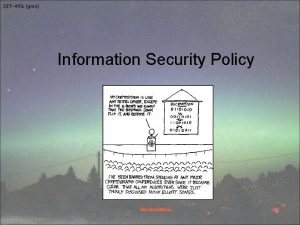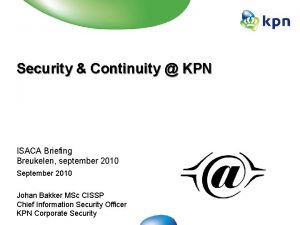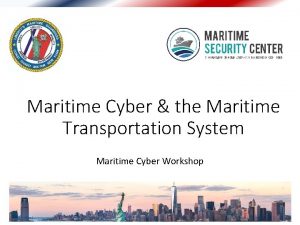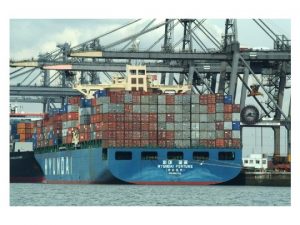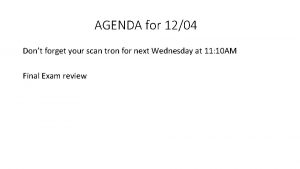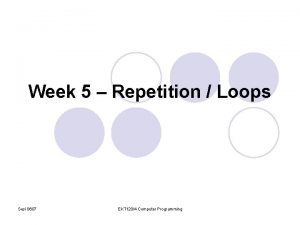Maritime Security Guidelines HSPD13 Maritime Security Policy 1204















- Slides: 15


Maritime Security Guidelines • HSPD-13 Maritime Security Policy (12/04) • The National Strategy for Maritime Security (9/05) – – – – Nat’l plan to achieve domain awareness Maritime Intelligence integration Maritime ops threat response Int’l outreach and coord. Infrastructure recovery plan Transportation system security plan Commerce security plan Domestic outreach plan

Threats • Nation States • Terrorists • Transnational Criminals/ Pirates WMD – “Preeminent among our national security priorities is to take all necessary steps to prevent WMD from entering the country and to avert an attack on the homeland” (reaches to biological, chemical and radiological material)

Domains of Interest • Maritime Domain/ Infrastructure – 80 % of world trade is over water – 50% of world trade by value and 90% of cargo transported in containers – 30 mega port world wide cities – 75% of world trade and 50% oil consumption passes thru “chokepoints” (straits and canals)

Domains of Interest (PA-NY/NJ) • Maritime plus – – 4 Airports Bridges Tunnels Path Tubes • Suggests? ? ? – Involvement in all areas of Emergency Management to include preparedness, interdiction, response, recovery AND information and intelligence sharing…vertically and laterally

The Praxis Begins 1. In 2003, a New York/New Jersey Radiological Pilot Program (RPP) was implemented from a DHS grant to develop and deploy a defense-in-depth perimeter around New York City for the detection, interdiction, and resolution of potential radiological or nuclear threats. 2. The PA-NY/NJ designated to lead the development of a communications, command control framework to provide for the dissemination of sensor alert information and the coordination for planning and response.

Figure 1: Operational View - Regional Steering Committee

Praxis Continues 3. Development of RIJAN Prototype (Regional Information Joint Awareness Network) 4. SSA interface and transport bus architecture 5. CWID exercise – proof of concept Coalition Warrior Interoperability Demo – sponsored by Chairman JCS to test C 4 ISR (command, control, communication, computers, intelligence, surveillance, recon) THESE CONCEPTS ARE NOT UNDERSTOOD BY NONMILITARY AGENCIES

CWID Exercise Components Test of technology and human collaboration 1. 2. 3. 4. 5. 6. 7. Radioactive shipment (cobalt 60) from Canada to Port in NJ goes missing NY State Police assume incident control – issue bolo to NY “law enforcement” w/parallel comm. to RIJAN Truck found abandoned in rural NY- radioactive material missing NYS police coordinate region wide search for missing material Collaborative brief held over RIJAN SSA technology Radiological detection sensor triggered at Lincoln Tunnel Toll Plaza sensor info relayed to RIJAN SSA and Lawrence Livermore national labs- vehicle sent to screening point Port authority now assumed incident control, SSA enhanced by integrating video camera feeds and helicopter video

Figure 2: RIJAN Shared Situational Awareness (SSA)


Initial Collaboration NY State and RIJAN • Crucial elements of the event • Establishment of a perimeter and regional checkpoints • Soliciting radiological technical advice from federal sources • Activation of regional Emergency Operations Centers • Dissemination of critical law-enforcement information • Requests for federal resources • Engaging and alerting adjoining states and related agencies

Exercise observation and results • • • Observations from the CWID exercise provided the following lessons learned: Provide information to executives and operators in a form they can use wherever they may be Shape technology around existing operational and institutional cultures Leverage existing infrastructure and legacy systems to the greatest extent Adopt standard business rules and formats for information exchange and collaboration Provide operational users easy to use voice, video, sensor data, GIS mapping and other collaboration tools to enable informed decision making

My Observations and Research Direction(s) • CWID like exercises should occur in our region more frequently • SSA and Interface design • Rethinking “enterprise architecture” and the role of SOA • Teams, virtual teams, horizontal and vertical collaboration • NJIT architecture SWAT team researching RIJAN and EPINet

 Trbs 1204
Trbs 1204 E commerce security policy
E commerce security policy Ministry of maritime affairs and insular policy
Ministry of maritime affairs and insular policy Integrated maritime policy
Integrated maritime policy Do no. 36, s. 2016
Do no. 36, s. 2016 Policy guidelines on nat/ncae
Policy guidelines on nat/ncae Private securit
Private securit Maritime security risk analysis model
Maritime security risk analysis model Kebijakan keamanan sistem informasi
Kebijakan keamanan sistem informasi Database security issues
Database security issues Database security policy
Database security policy Fbi cjis security policy
Fbi cjis security policy Ncic restricted files
Ncic restricted files Xkcd specifications
Xkcd specifications Isaca business continuity
Isaca business continuity Pearson vue pcnse
Pearson vue pcnse


